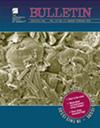Lateral and vertical characteristics of floodplain aggradation cycles in the lower Eocene Willwood Formation, Bighorn Basin, Wyoming, USA
IF 3.9
1区 地球科学
Q1 GEOSCIENCES, MULTIDISCIPLINARY
引用次数: 0
Abstract
Sedimentation on river floodplains is a complex process that involves overbank flooding, crevasse splaying, and river avulsion. The resulting floodplain stratigraphy often exhibits floodplain aggradation cycles with alternating fine-grained overbank flooding deposits that underwent significant petrogenesis, and coarser-grained, avulsion-belt deposits largely devoid of pedogenic impact. These cycles are linked to lateral migration and avulsion of channels driven by internal dynamics, external factors, or a combination of both. To better understand the spatial and vertical variability of such floodplain aggradation cycles, we map these in three dimensions using a photogrammetric model of the lower Eocene Willwood Formation in the northern Bighorn Basin, Wyoming, USA. This allows identifying 44 floodplain aggradation cycles in ∼300 m of strata with an average thickness of 6.8 m and a standard deviation of 2.0 m. All the cycles are traceable over the entire model, pointing to their spatial consistency over the 10 km2 study area. At the same time, rapid lateral thickness changes of the floodplain aggradation cycles occur with changes up to 4 m over a lateral distance of 400 m. Variogram analyses of both field and numerical-model results reveal stronger consistency of floodplain aggradation cycle thicknesses along the paleoflow direction compared to perpendicular to paleoflow. Strong compensational stacking occurs at the vertical scale of 2−3 floodplain aggradation cycles (14−20 m), while full compensational stacking occurs at larger scales of more than six floodplain aggradation cycles (>41 m). The lateral and vertical thickness variability of the floodplain aggradation cycles, as well as their compensational stacking behavior, are interpreted to be dominantly driven by autogenic processes such as crevasse splaying and avulsing that preferentially fill topographic lows. External climate forcing may have interacted with these autogenic processes, producing the laterally persistent and vertically repetitive floodplain aggradation cycles. The spatial variability of floodplain aggradation cycles demonstrated in this study highlights again the need for three-dimensional data collection in alluvial floodplain settings rather than depending on one-dimensional records.美国怀俄明州比格霍恩盆地下始新世Willwood组洪泛平原沉积旋回的横向和纵向特征
河漫滩上的沉积是一个复杂的过程,包括堤岸洪水、裂缝伸展和河流崩解。由此形成的河漫滩地层通常表现为河漫滩沉积旋回,其中细粒的河岸泛洪沉积经历了重要的岩石成因,而粗粒的剥落带沉积基本上没有成土影响。这些旋回与内部动力、外部因素或两者共同驱动的河道侧向移动和撕裂有关。为了更好地理解这种洪泛平原沉积旋回的空间和垂直变化,我们利用美国怀俄明州比格霍恩盆地北部始新世下威尔伍德组的摄影测量模型在三维空间上绘制了这些变化。这允许在~ 300米的地层中识别44个洪泛平原沉积旋回,平均厚度为6.8米,标准偏差为2.0米。所有周期在整个模型中都是可追溯的,这表明它们在10平方公里研究区域内的空间一致性。与此同时,洪泛平原沉积旋回的横向厚度发生了快速变化,在400 m的横向距离上变化最大可达4 m。野外和数值模拟结果的方差分析表明,河漫滩沉积旋回厚度沿古水流方向的一致性比垂直于古水流方向的一致性强。在2 ~ 3个河漫滩沉积旋回(14 ~ 20 m)的垂直尺度上发生强烈的补偿堆积,而在6个以上河漫滩沉积旋回(41 m)的更大尺度上发生完全补偿堆积。被解释为主要是由自生过程驱动的,如裂缝的展开和剥落,优先填充地形低洼。外部气候强迫可能与这些自生过程相互作用,产生横向持续和垂直重复的洪泛平原沉积旋回。本研究显示的洪泛区沉积旋回的空间变异性再次强调了在冲积洪泛区环境中需要三维数据收集,而不是依赖于一维记录。
本文章由计算机程序翻译,如有差异,请以英文原文为准。
求助全文
约1分钟内获得全文
求助全文
来源期刊

Geological Society of America Bulletin
地学-地球科学综合
CiteScore
9.30
自引率
8.20%
发文量
159
审稿时长
4-8 weeks
期刊介绍:
The GSA Bulletin is the Society''s premier scholarly journal, published continuously since 1890. Its first editor was William John (WJ) McGee, who was responsible for establishing much of its original style and format. Fully refereed, each bimonthly issue includes 16-20 papers focusing on the most definitive, timely, and classic-style research in all earth-science disciplines. The Bulletin welcomes most contributions that are data-rich, mature studies of broad interest (i.e., of interest to more than one sub-discipline of earth science) and of lasting, archival quality. These include (but are not limited to) studies related to tectonics, structural geology, geochemistry, geophysics, hydrogeology, marine geology, paleoclimatology, planetary geology, quaternary geology/geomorphology, sedimentary geology, stratigraphy, and volcanology. The journal is committed to further developing both the scope of its content and its international profile so that it publishes the most current earth science research that will be of wide interest to geoscientists.
 求助内容:
求助内容: 应助结果提醒方式:
应助结果提醒方式:


